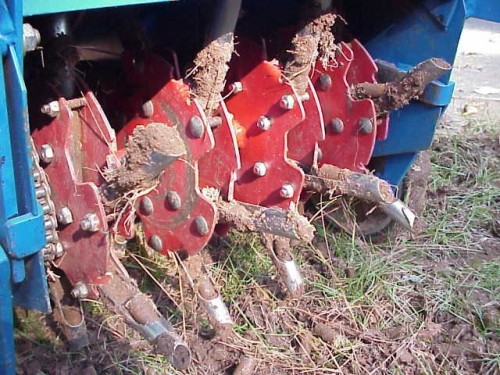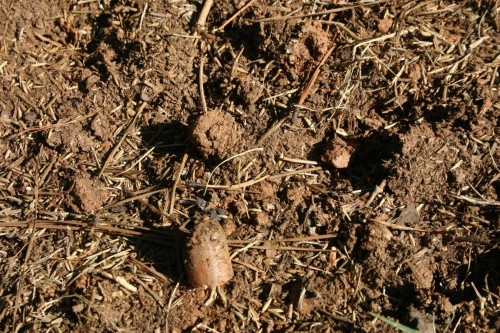





Anyone who has wielded a shovel in Atlanta knows that the soil usually contains a lot of clay. The tiny clay particles are easily packed tightly together by rain and foot traffic. After a hot Southern summer, the earth can seem like it is made of bricks!
The soil under a lawn becomes harder and harder as the years pass. It is rained on, walked on, played on and mowed regularly. Digging up the whole lawn to soften the soil is usually out of the question. What can be done to loosen the earth in a lawn while avoiding extreme damage to the lawn grass?
The answer is to “aerate” the lawn – using a rented machine (an aerator) which pokes holes in the ground and loosens it. The holes allow oxygen and water to penetrate more deeply. This causes roots to go deeper, making the lawn more resistant to drought and disease.
According to The Lawn Institute, over two-thirds of American lawns are growing on compacted soils. The signs of compaction are tricky to detect: grass seems to be off-color, thinning and shows signs of stress in high temperatures. Because the grass is weak, it may be susceptible to disease and insect damage.
Aeration is the process of mechanically poking thousands of holes in the soil. This allows water, oxygen and nutrients to better penetrate to the roots of your grass. Motorized aerator machines can be rented from hardware or tool rental stores.
WHEN TO AERATE The best time to aerate a lawn is just before the grass begins to grow rapidly. Fescue grass makes most of its productive growth in fall, so September and October are prime months to aerate fescue lawns. Bermuda, zoysiagrass and centipedegrass lawns are best to aerate in April – just as they have completed green-up, ready for vigorous growth.
WHICH AERATOR? Dr. Robert Carrow, University of Georgia turf expert, compared the effect of aerating with a “core” aerator versus a “spike” aerator. The hollow tines (sometimes called “spoons”) of a core aerator plunge into the ground and pull up a large plug of earth. Spike aerators insert narrow, solid rods into the earth. He found that the core aerator increased deep rooting and water extraction by 25 percent. The spike aerator showed no effects on grass health.
THATCH REMOVAL In addition to the deeper roots, the plugs of soil that are deposited on top of the ground help decompose thatch – without the risk of turf damage that power dethatchers pose. If you are doing a light fall overseeding on a fescue lawn, the holes left by the aerator make a perfect place for the seeds to fall into and germinate. Fertilizer also penetrates more deeply and helps a lawn recover and look its best after aerating!
Q: I used a hollow-tine aerator on my lawn. Do I have to collect the little plugs of soil that the aerator left behind?
A: Thank goodness you don’t have to collect them! You do have two choices, though. You can either let them gradually disappear or you can drag a section of carpet or chainlink fence over them to break them up. Wait three or four days after the aeration, allowing them to dry, before you drag and crumble the plugs.
Q: My neighbor has a spike aerator that he pulls behind his yard tractor. Will this aerate as well as a hollow-tine aerator that I have to pay to rent?
A: Not at all! In fact, the spike aerator may do more harm than good. It all has to do with the physics of pushing something into the earth. A solid object, like an aerator spike, tends to compact the soil below and on either side of the hole it makes. It also glazes the side of the hole as it withdraws, making penetration of air and nutrients more difficult. Remember, the process is called “aeration”, after all. Anything that impedes oxygen getting to grass roots doesn’t help them. The hollow tines that plunge into the ground and withdraw a plug of soil do not compact the soil and they do allow oxygen movement. Hollow-tine aerators are the best.
Q: How often should I aerate?
It all depends on how hard your soil is. You can get an idea by doing this: Wait five days after a rain and try to poke a Phillips head screwdriver into the soil. If it only penetrates easily an inch, it’s time to aerate. A lot of folks aerate once each year and say it does their lawn a great deal of good.

aerator

aerator cores
Copyright © www.100flowers.win Botanic Garden All Rights Reserved